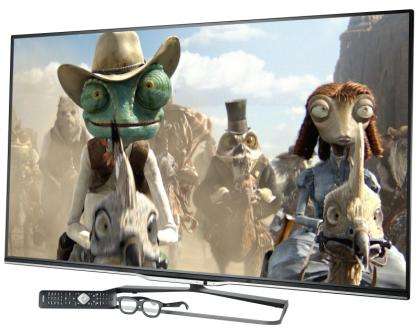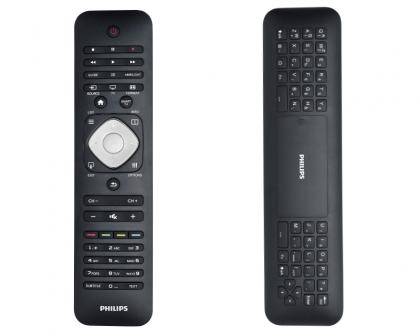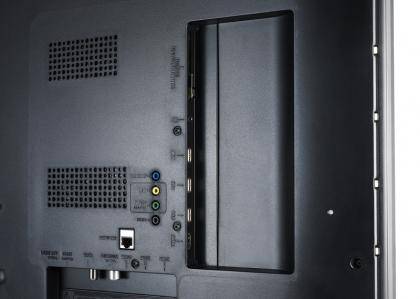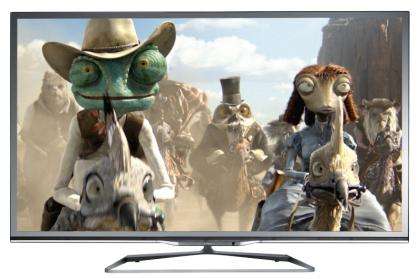For this review we tested the 55in model in the 7008S range, but it's also available in 42in (42PFL7008S) and 47in (47PFL7008S) screen sizes. All models have identical specifications except for their dimensions and power usage. We're confident that image quality will be practically identical across the range.
The 55PFL7008S is one of Philips’ top of the range LCD smart TVs. As with other TVs in this range, its tiny stand makes it by far one of the most striking TVs we’ve seen this year. It’s a refreshing change from the large flat stands we’ve seen from other manufacturers, and it’s surprisingly sturdy, too. The TV's ultra-thin bezel means the screen extends virtually to the edges of the TV.

Philips’ AmbiLight LEDs run across the top, and down the left and right edges to create a halo of light behind the set. It works best when it’s set to Dynamic mode, as this matches the colours of what’s being shown on screen, but it can also show a static white light instead that helps to make colours stand out. It helps makes watching TV more immersive, giving the impression of a bigger picture, although you can turn it off if you find the effect distracting.
SMART TV
You’ll need to go through a setup process when you first turn it on, but once you’ve installed the channels and connected the TV to your home network via its integrated Wi-Fi or wired LAN port, you’re ready to use Philips’ Smart TV portal. Here you’ll find popular apps like BBC iPlayer, Netflix, BlinkBox and YouTube, and a separate Social icon handles Twitter and Facebook.
There’s also an online store where you can download more apps, but at this price we would have expected to see a lot more services pre-installed. Other catch-up TV services like ITV Player, 4OD and Demand on 5 have all been promised to appear later in the year, but we’ve yet to see them implemented.
This creates an overlay menu on the side of the screen so you can tweet and post updates while you watch TV. The remote also has a handy keyboard on the back so you won’t have to connect a keyboard for typing, and its motion control sensors make it very easy to navigate its menus and browse the web. Skype’s also present, and the integrated camera at the bottom of the screen means you can start making video calls straight away.

The 7008S dual core processor isn’t quite as snappy as we’d like when loading menus and we often had to wait a few seconds before the next screen loaded. This isn’t too noticeable in everyday use, but a quad-core processor would have helped to set it apart from more sluggish mid-range sets.
There’s a wide variety of inputs on the back panel, including four HDMI inputs, a component input, SCART via an adapter, a Common Interface slot, digital optical audio, a headphone jack and an audio L/R input. There’s also a satellite tuner in addition to its Freeview HD tuner, although it's not compatible with Freesat HD, so you won't be able to get the EPG even if you tune in the channels manually.
PORTS AND AUDIO
There are also three USB ports that you can use to play your own media files, and the TV supports streaming over a home network using DLNA. We had no problem playing our test video and all of our files worked perfectly. Audio wasn’t quite as well supported, though, as it only played our M4A, MP3, WAV and WMA files. Images were even more selective, as it only recognised our JPG files. You can also use the USB ports for connecting an external flash drive to record programmes and pause digital recording. You’ll need at least 250GB of free storage to record programmes, but provided your hard disk is large enough, you could use it as your own personal PVR.

Its pair of 12W speakers were also impressive. With enough volume to fill a hall, there was plenty of bass present along with rich, full sound. In this case, we didn’t particularly feel the need for a sound bar, at least not for everyday use, but it doesn’t quite replace a full surround sound system.
IMAGE QUALITY
We were immediately impressed with the TV's picture quality, as even low quality Freeview HD channels like BBC News looked good in standard definition. Channels upscaled very well, showing only a small amount of noise and compression on its default settings, but we managed to retain a good level of detail when we used the noise reduction feature.
Picture settings are quite hard to find in amongst its various menu options. You’ll have to press the Home button on the remote and find the Setup menu before you can access the TV settings, but there are plenty of options to help improve the image quality once you’ve found it.
Philips’ Pixel Precise HD feature contains advanced sharpness settings, dynamic backlight and contrast, colour enhancement and its Perfect Natural Motion option. This acts as Philips’ frame interpolation setting, but while we didn’t see a huge difference while watching TV, it made a big impact when we switched to our Blu-Ray test footage.

We were a little disappointed with it, though. It certainly helped smooth out fast-paced action sequences, but it was far too strong during more sedate scenes and made everything look like a soap opera. With no way of obtaining an easy middle-ground, we ended up turning it off and settling for slightly jerky camera movements instead. This is a shame, as we felt this was quite a big compromise on a £2,000 TV, particularly when its overall picture quality was much more promising.
We used the Personal picture mode as our starting point, but while colours were also quite muted at first, this was easily improved by increasing the regular colour settings. It’s also possible to tweak the colour temperature using the advanced custom colour temperature setting.
We found the 55PFL7008S's default black levels were great and it had the contrast levels to match. Night scenes were full of detail, although we’d recommend setting the dynamic backlight setting to standard if you’re watching films during the day as the panel isn’t particularly bright.
3D QUALITY
As we’d expect from a top of the range TV, the 7008S is also 3D ready. It uses passive 3D and comes with four pairs of glasses. Its 3D settings are quite sparse, as the only option is to change the 3D depth or convert 2D images into 3D, but it handled 3D content very well. The glasses aren’t very dark, so colours really came to life in our reference scenes of Avatar and the depth of field was superb.
We didn’t see any evidence of crosstalk or ghosting either, although its image processing was arguably worse here than our 2D footage. We definitely felt the need to turn on the frame interpolation in our reference scenes, despite its unnatural amount of smoothing.
CONCLUSION
Ultimately, the Philips 55PFL7008S feels like a step backwards compared to the Philips 55PFL6008S , which is now available for as little as £1,300. It’s just a little too compromised to justify its price and Philips seriously needs to bolster its smart TV offering. We'd go for the cheaper Philips set instead if you want a reasonably-priced 55in set.
|
Basic Specifications |
|
Rating |
*** |
|
Physical |
|
Viewable size |
55in |
|
Native resolution |
1,920x1,080 |
|
1080p support |
Yes |
|
Aspect ratio |
16:9 |
|
HD ready |
yes |
|
3D capable |
yes |
|
Contrast ratio |
500,000:1 dynamic |
|
Brightness |
400cd/m² |
|
Speakers |
2x 12W |
|
Connections |
|
D-sub inputs |
0 |
|
HDMI inputs |
4 |
|
Component inputs |
1 |
|
SCART |
1 |
|
Composite inputs |
0 |
|
Audio outputs |
optical S/PDIF out, 1x 3.5mm input, 1x 3.5mm output |
|
Other |
headphone output, CI slot, 3x USB, LAN port, Wi-Fi |
|
Tuner |
|
Tuner type |
Freeview HD, DVB-S2 |
|
EPG |
8 day |
|
Environmental |
|
Power consumption standby |
0W |
|
Power consumption on |
63W |
|
Buying Information |
|
Warranty |
five years collect and return |
|
Price |
£2,000 |
|
Supplier |
http://www.purewell.co.uk |
|
Details |
www.philips.co.uk |
Basic Specifications
Physical
Connections
Tuner
Environmental
Buying Information
